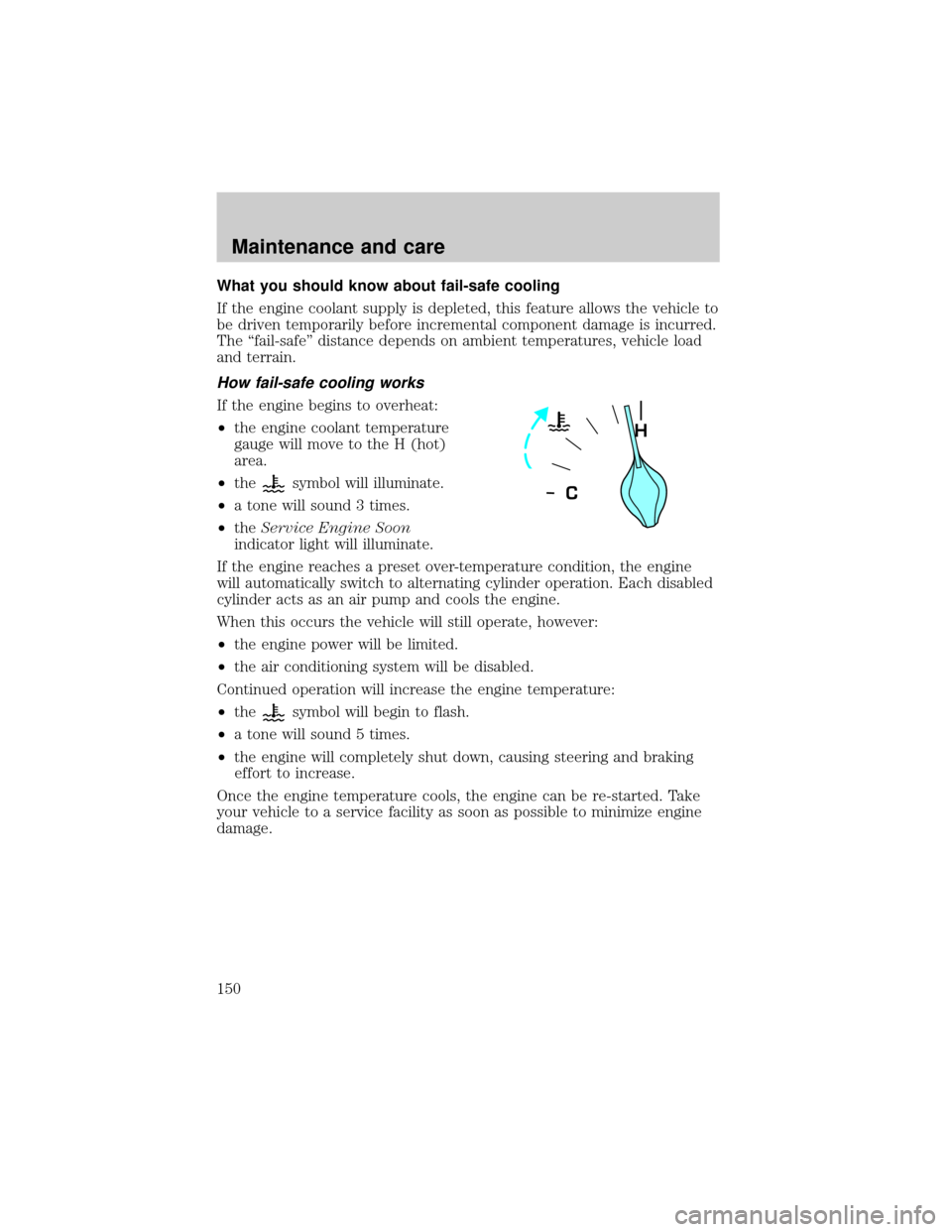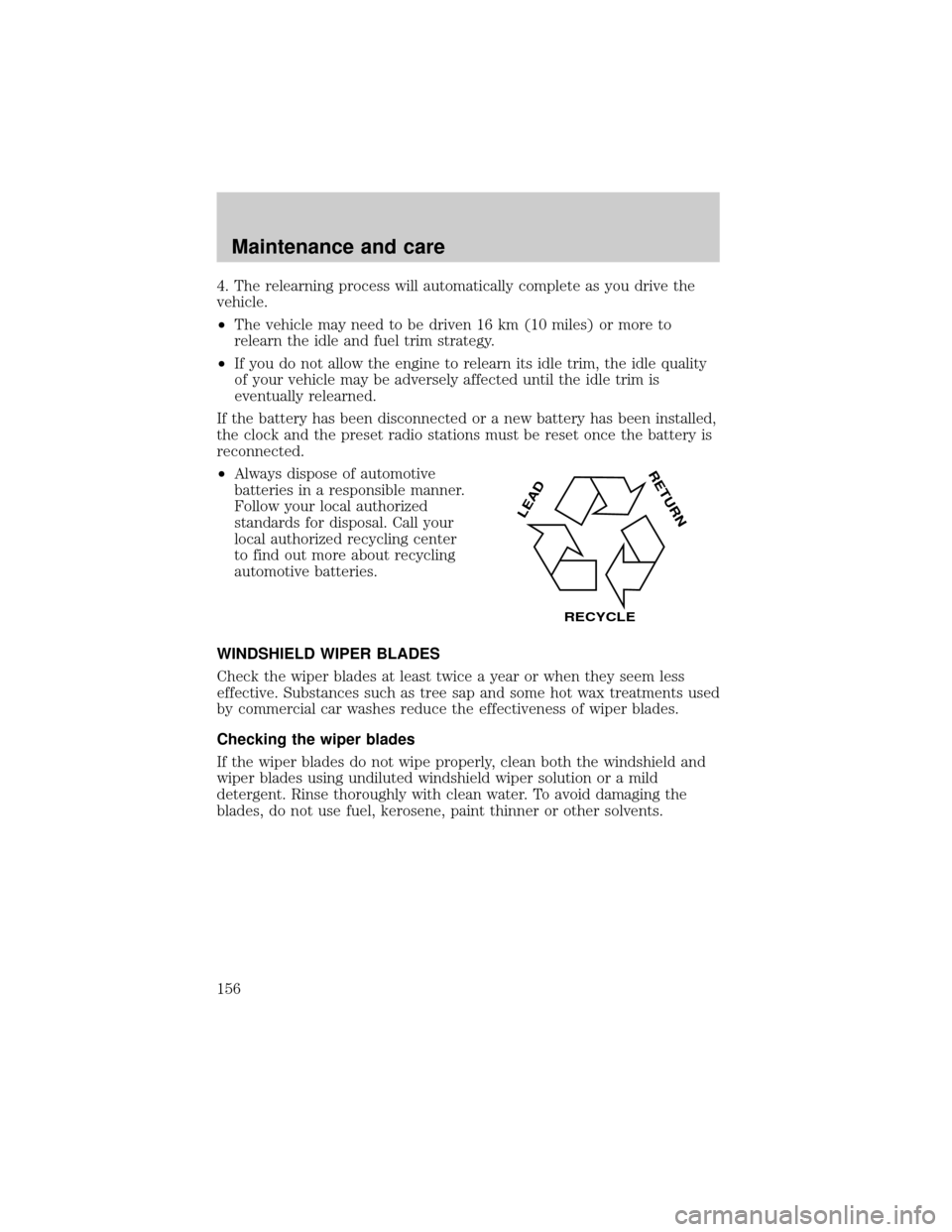1999 LINCOLN TOWN CAR maintenance reset
[x] Cancel search: maintenance resetPage 150 of 208

What you should know about fail-safe cooling
If the engine coolant supply is depleted, this feature allows the vehicle to
be driven temporarily before incremental component damage is incurred.
The ªfail-safeº distance depends on ambient temperatures, vehicle load
and terrain.
How fail-safe cooling works
If the engine begins to overheat:
²the engine coolant temperature
gauge will move to the H (hot)
area.
²the
symbol will illuminate.
²a tone will sound 3 times.
²theService Engine Soon
indicator light will illuminate.
If the engine reaches a preset over-temperature condition, the engine
will automatically switch to alternating cylinder operation. Each disabled
cylinder acts as an air pump and cools the engine.
When this occurs the vehicle will still operate, however:
²the engine power will be limited.
²the air conditioning system will be disabled.
Continued operation will increase the engine temperature:
²the
symbol will begin to flash.
²a tone will sound 5 times.
²the engine will completely shut down, causing steering and braking
effort to increase.
Once the engine temperature cools, the engine can be re-started. Take
your vehicle to a service facility as soon as possible to minimize engine
damage.
H
Maintenance and care
150
Page 156 of 208

4. The relearning process will automatically complete as you drive the
vehicle.
²The vehicle may need to be driven 16 km (10 miles) or more to
relearn the idle and fuel trim strategy.
²If you do not allow the engine to relearn its idle trim, the idle quality
of your vehicle may be adversely affected until the idle trim is
eventually relearned.
If the battery has been disconnected or a new battery has been installed,
the clock and the preset radio stations must be reset once the battery is
reconnected.
²Always dispose of automotive
batteries in a responsible manner.
Follow your local authorized
standards for disposal. Call your
local authorized recycling center
to find out more about recycling
automotive batteries.
WINDSHIELD WIPER BLADES
Check the wiper blades at least twice a year or when they seem less
effective. Substances such as tree sap and some hot wax treatments used
by commercial car washes reduce the effectiveness of wiper blades.
Checking the wiper blades
If the wiper blades do not wipe properly, clean both the windshield and
wiper blades using undiluted windshield wiper solution or a mild
detergent. Rinse thoroughly with clean water. To avoid damaging the
blades, do not use fuel, kerosene, paint thinner or other solvents.
LEAD
RETURN
RECYCLE
Maintenance and care
156
Page 170 of 208

engine. This decal identifies engine displacement and gives some tune up
specifications.
Please consult your ªWarranty Guideº for complete emission warranty
information.
Readiness for Inspection/Maintenance (I/M) testing
In some localities, it may be a legal requirement to pass an I/M test of
the on-board diagnostics system. If your ªCheck Engine/Service Engine
Soonº light is on, refer to the description in theWarning Lights and
Chimessection of theInstrumentationchapter. Your vehicle may not
pass the I/M test with the ªCheck Engine/Service Engine Soonº light on.
If the vehicle's powertrain system or its battery has just been serviced,
the on-board diagnostics system is reset to a ªnot ready for I/M testº
condition. To ready the on-board diagnostics system for I/M testing, a
minimum of 30 minutes of city and highway driving is necessary as
described below:
²First, at least 10 minutes of driving on an expressway or highway.
²Next, at least 20 minutes driving in stop-and-go, city-type traffic with
at least four idle periods.
Allow the vehicle to sit for at least eight hours without starting the
engine. Then, start the engine and complete the above driving cycle. The
engine must warm up to its normal operating temperature. Once started,
do not turn off the engine until the above driving cycle is complete.
EXTERIOR BULBS
Replacing exterior bulbs
Check the operation of the following lamps frequently:
²Headlamps
²Tail lamps
²Brakelamps
²High-mount brakelamp
²Turn signals
²Backup lamps
²License plate lamp
Maintenance and care
170
Page 202 of 208

GAWR
(Gross Axle Weight Rating) .....118
definition .................................118
driving with a heavy load ......118
location ....................................118
GVWR (Gross
Vehicle Weight Rating) .............118
calculating ...............................118
definition .................................118
driving with a heavy load ......118
location ....................................118
Hazard flashers .........................123
Head restraints ...........................80
Headlamps ...................................21
aiming ........................174,175,176
autolamp system .......................21
bulb specifications ..................174
daytime running lights .............21
flash to pass ..............................22
high beam ..............................8,22
turning on and off ....................21
warning chime ..........................12
Heating ........................................22
Hood ..........................................142
Ignition .......................................184
positions of the ignition ...........53
Infant seats
(see Safety seats) .......................99
Inspection/maintenance
(I/M) testing ..............................170
Instrument panel
cleaning ...................................179
lighting up panel
and interior ...............................21
location of components ..............6
Jump-starting your vehicle ......135
Keyless entry system .................75
autolock .....................................73
keypad .......................................75
programming entry code .........75
Keys .............................................54
key in ignition chime ...............12positions of the ignition ...........53
Lamps
autolamp system .......................21
cargo lamps ...............................21
daytime running light ...............21
headlamps .................................21
headlamps, flash to pass ..........22
instrument panel, dimming .....21
interior lamps ....................64,174
replacing bulbs ..170,171,173,174
Lane change indicator
(see Turn signal) ........................54
Lights, warning and indicator ......6
air bag ..........................................7
air suspension ...........................10
anti-lock brakes (ABS) .......8,110
brake ............................................8
charging system ..........................9
cruise indicator .........................11
door ajar ....................................10
high beam ...................................8
liftgate ajar ................................10
low coolant ..................................9
low washer fluid .......................11
oil pressure .................................9
safety belt ...................................7
service engine soon ....................6
speed control ............................58
traction control system .........9,11
turn signal indicator ...................8
Load limits .................................118
GAWR ......................................118
GVWR ......................................118
trailer towing ..........................118
Locks
childproof ..................................68
doors ..........................................67
Lubricant specifications ....182,184
Lumbar support, seats ...............83
Message center ...........................14
reset button ..............................15
select button .............................15
Index
202